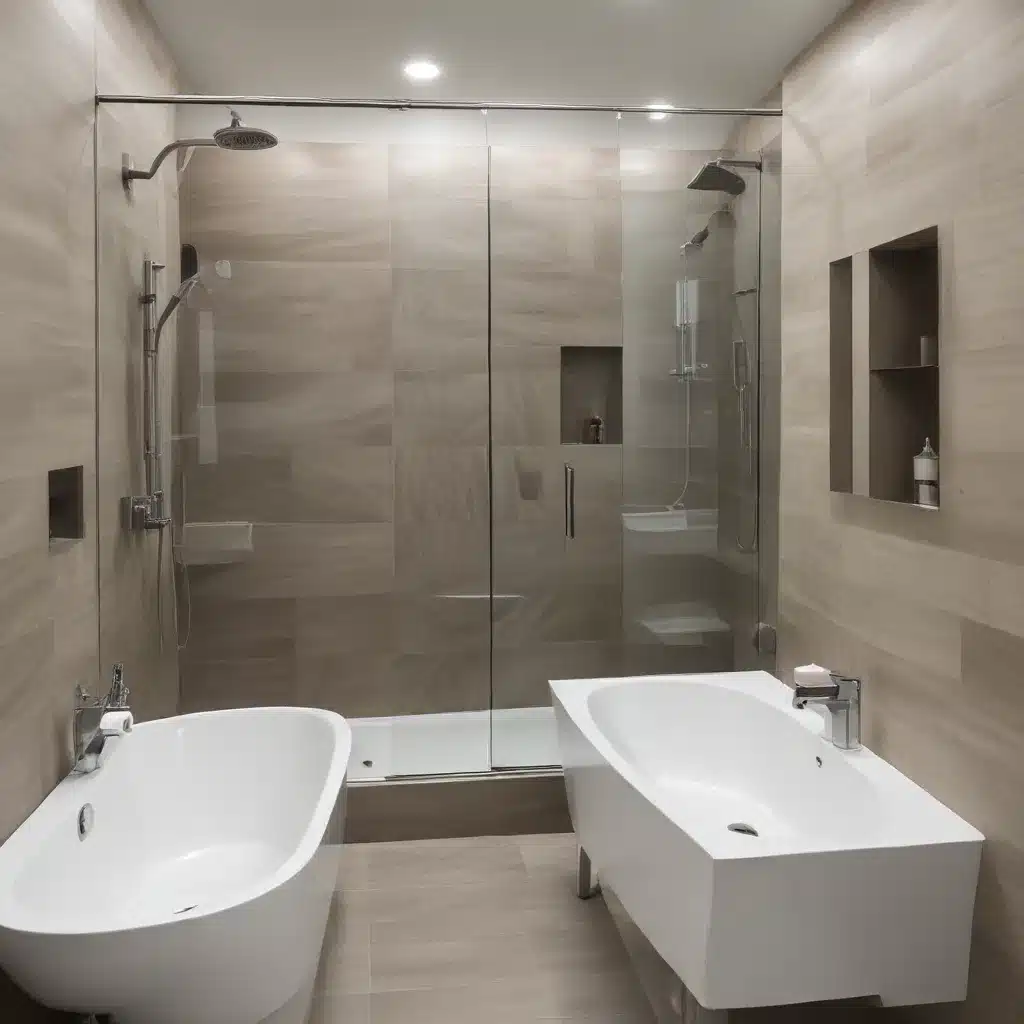
Maximizing Space with Thoughtful Bathtub Selections
When dealing with a compact bathroom, every square inch of space counts. The bathtub is often the centerpiece of the room, so choosing the right tub configuration can make a significant difference in the overall functionality and aesthetic of the space. From modern freestanding models to space-saving built-in options, there are a variety of bathtub styles that can help transform even the smallest of bathrooms.
One key consideration when selecting a bathtub for a compact bathroom is the tub’s footprint. Freestanding tubs, while visually striking, can take up a considerable amount of floor space. However, their open design can create an illusion of greater roominess. Alternatively, built-in tubs that are seamlessly integrated into the surrounding cabinetry or tile work can be an excellent choice for maximizing usable floor area. These tubs often feature a more compact silhouette, making them an ideal fit for tight quarters.
For homeowners seeking an even more streamlined solution, alcove-style tubs can be an excellent option. These tubs are designed to fit snugly into a pre-existing alcove or recess, minimizing the amount of floor space required. By eliminating the need for additional clearance around the tub, alcove configurations can free up valuable square footage for other bathroom essentials, such as vanities, storage, or even a separate shower enclosure.
Bathtub Materials: Balancing Durability and Aesthetics
When it comes to bathroom renovations, the selection of bathtub materials can have a significant impact on the overall look and feel of the space. Porcelain-enameled steel tubs are a popular choice due to their affordability and easy maintenance, making them a practical option for budget-conscious homeowners. Acrylic tubs, on the other hand, offer a lightweight and durable alternative, often featuring a sleek, modern appearance that can complement a variety of design styles.
For those seeking a more high-end aesthetic, cast iron tubs remain a timeless and luxurious option. While they can be heavier and more challenging to install, cast iron tubs are renowned for their exceptional durability and ability to retain heat, providing a relaxing bathing experience. Fiberglass tubs are another budget-friendly choice, offering a smooth, seamless surface that can be customized with various color and texture options.
When selecting a bathtub material, it’s essential to consider not only the visual appeal but also the practical aspects of maintenance and long-term performance. Consulting with experienced bathroom designers or contractors can help homeowners make an informed decision that balances their design preferences with the realities of their space and budget.
Bathroom Remodeling Strategies for Compact Spaces
Renovating a small bathroom requires a strategic approach to maximize the available space and create a cohesive, visually appealing design. One effective technique is the use of mirrored surfaces, which can create the illusion of a larger, more open room. By strategically placing mirrors, whether as a full-wall treatment or as part of a vanity unit, homeowners can capitalize on the reflective properties to enhance the sense of depth and brightness within the space.
Another space-saving strategy is the incorporation of floating vanities and pedestal sinks. These minimalist fixtures eliminate the bulky cabinetry that can make a small bathroom feel cramped, instead offering a clean, streamlined aesthetic that can visually “open up” the room. The additional floor space created by these solutions can be utilized for storage or to accommodate other essential bathroom elements, such as a compact toilet or a space-efficient shower enclosure.
When it comes to tile selection, larger format tiles or a continuous tile pattern can be leveraged to create a more cohesive and visually expansive appearance. By minimizing the number of grout lines, the room can feel more seamless and visually uninterrupted, further enhancing the perception of spaciousness.
Innovative Tub Configurations for Compact Bathrooms
For homeowners with particularly tight spaces, Japanese-style soaking tubs can be an excellent alternative to traditional full-size bathtubs. These compact, deep tubs are designed to provide a relaxing, immersive bathing experience while occupying a minimal footprint. By focusing on depth rather than length, soaking tubs can be strategically placed in corners or recessed alcoves, freeing up valuable floor space for other essential bathroom elements.
Another innovative solution for compact bathrooms is the clawfoot tub. While these freestanding tubs were historically large and cumbersome, modern iterations have been designed with more compact dimensions to suit smaller bathroom layouts. By positioning the clawfoot tub against a wall or in a corner, homeowners can enjoy the classic charm of this timeless bathtub style without sacrificing too much floor space.
For bathrooms with tight constraints, corner tubs can be an excellent option. These triangular-shaped tubs are designed to fit snugly into the corner of a room, maximizing the available square footage while still providing a comfortable and functional bathing experience. By strategically positioning the tub, homeowners can create a visually interesting focal point within the compact bathroom.
Bathtub Installation and Renovation Considerations
Proper bathtub installation is crucial for the long-term performance and aesthetics of the bathroom. Experienced plumbers and bathroom contractors should be consulted to ensure that the tub is securely anchored, properly leveled, and integrated seamlessly with the surrounding finishes. This attention to detail can help prevent issues such as leaks, cracks, or uneven surfaces that can detract from the overall appearance and functionality of the space.
When undertaking a bathroom renovation, it’s essential to consider the accessibility and mobility requirements of the space. For homeowners with limited mobility or aging in place, the selection of a walk-in bathtub or barrier-free shower can be a significant factor in creating a safe and comfortable bathroom environment. These specialized fixtures prioritize ease of use and accessibility, allowing for a more inclusive and adaptable bathroom design.
Ultimately, the key to a successful compact bathroom renovation lies in a careful balance of form and function. By thoughtfully selecting the right bathtub configuration, material, and supporting design elements, homeowners can transform even the smallest of bathrooms into a serene and practical oasis. For more information and inspiration, be sure to visit https://www.everybathtub.com/.

